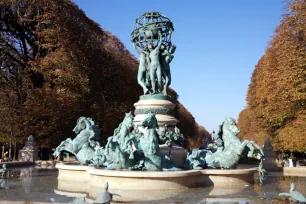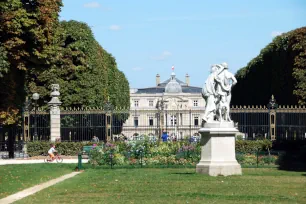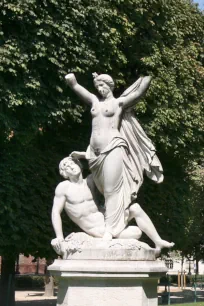The Avenue de l’Observatoire connects the Jardin du Luxembourg – one of Paris’s most popular parks – with the Observatory of Paris. The north part of the avenue contains two gardens: the Jardin Marco Polo and the Jardin Robert Cavelier de la Salle.



Together the two gardens form one elongated park unofficially known as the Jardins de l’Observatoire (Observatory Gardens).
History
The gardens sit on a parcel of land that was once occupied by Castle Vauvert, built by King Robert le Pieux in the eleventh century. The castle was given to the monks of Chartres in the thirteenth century, but it was destroyed in 1790 during the French Revolution. Some of the land was claimed for the Luxembourg Garden, and some was developed into the Avenue de l’Observatoire.
In 1867, the park was established from designs by architect Jean Chalgrin. The gardens consist of expansive lawns and each are planted with four rows of chestnut trees that are typical of classic French gardens.
They provide plenty of shade for the walkways at Jardin de l’Observatoire. Flower beds are numerous, and both gardens also contain many notable pieces of sculpture.



The Gardens
The Marco Polo garden occupies the southern half of the Jardin de l’Observatoire. It is about 1 hectare (3 acres) in size and honors, of course, the great explorer of the same name.
The Robert Cavelier de la Salle garden is just a little larger than the Marco Polo Garden and pays homage to the 17th century French explorer who explored the Great Lakes, the Gulf of Mexico, and the Mississippi River. It was de la Salle who claimed the Mississippi basin as French territory.
Columns and statues are planted on the axis of the park. The statues were sculpted by nineteenth-century artists including Charles Gumery, Gustave Grauk, Jean-Joseph Perraud and François Jouffroy and show allegorical figures representing Day, Night, Dawn and Twilight. They are meant to commemorate the adventurous journeys undertaken by the explorers.
Both of the gardens have playgrounds for young visitors and also several ping-pong tables. Shaded benches are abundant and are a peaceful place to enjoy a rest.
Fontaine de l’Observatoire
The centerpiece in the Jardins de l’Observatoire is a monumental fountain situated at the south end of the Marco Polo garden. The fountain is known by several names, including the Fontaine des Quatre Parties du Monde (Fountain of the Four Parts of the World), the Fontaine de l’Observatoire or the Fontaine Carpeaux, after the main sculptor.
Designed in 1873 and supervised by Gabriel Davioud, the bronze masterpiece shows figures on a pedestal that represent Asia, Africa, Europe, and America. Asia is depicted by the figure of a Chinese woman; Europe is represented by the figure of a white woman; Africa is represented by the figure of a black woman, and America is depicted by the female figure of an American Indian. The four figures, created by Jean Baptiste Carpeaux, support a globe decorated with zodiac signs. The globe was created by Eugène Legrain. The pedestal is surrounded by prancing seahorses which were created by yet another sculptor, Emmanuel Frémiet. Statues of fish and turtles – also created by Frémiet – complete the lively scene.

